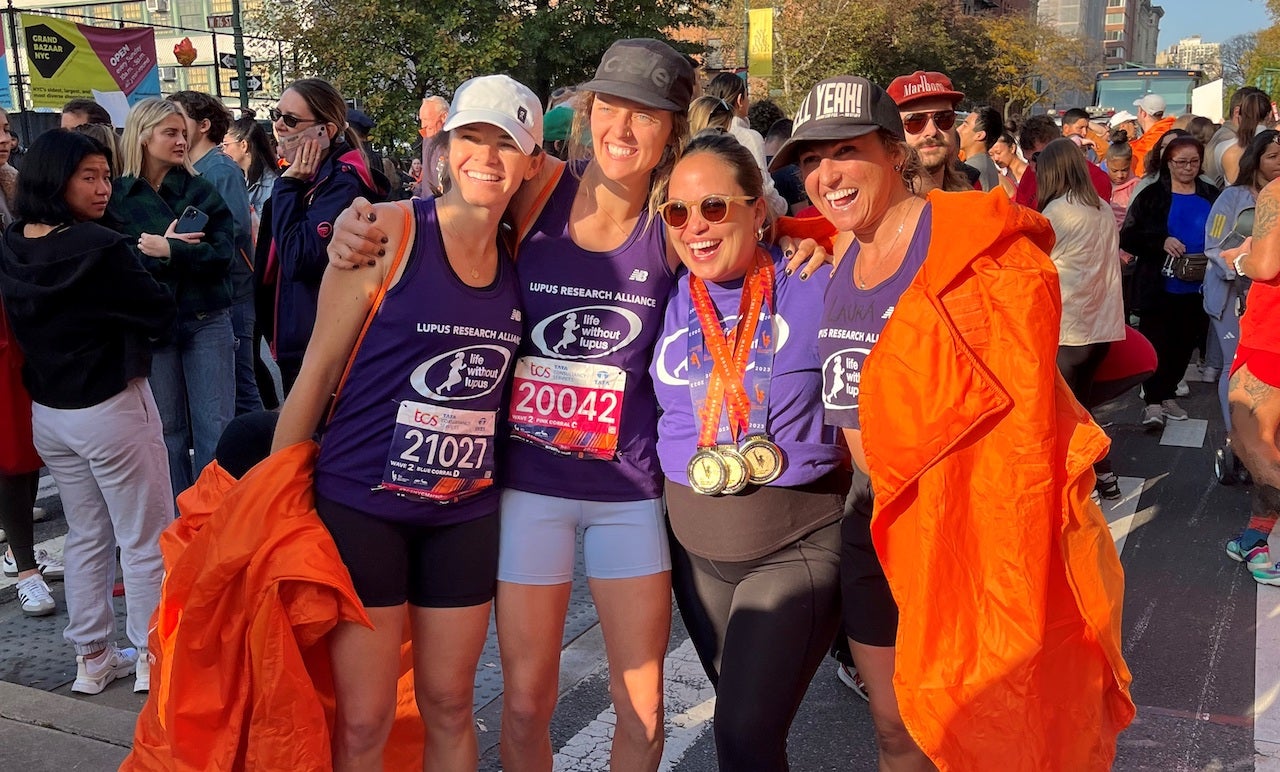Health
Friends run for a cure for lupus, completing NYC Marathon in honor of longtime pal and lupus sufferer

All marathoners have their own particular motivations for running a 26.2-mile race — and for Molly Anderson, Sarah Edwards and Laura Haley, it was to honor Rosie De Queljoe Herzog, their longtime friend who is living with lupus.
As a 30th birthday surprise, the three runners flew De Queljoe Herzog from her home in Los Angeles to the Big Apple, where she was able to cheer them on as they ran the New York City Marathon on Nov. 5.
Anderson, Edwards and Haley were part of Team Life Without Lupus, the official competitive team of the Lupus Research Alliance, the largest private funder of lupus research in the world.
FOR AUTOIMMUNE DISEASE SUFFERERS, GINGER MAY ‘PLAY A CRITICAL ROLE’ IN CONTROLLING INFLAMMATION, STUDY FINDS
The four friends shared with Fox News Digital what the experience meant to them — and how its impact is lasting well beyond that one day.
‘Something larger’
It was in 2021 when De Queljoe Herzog, a public relations professional, first started noticing symptoms, including rapid hair loss, joint pain, fatigue, swelling of her face and hands — and a malar rash (butterfly rash) on her face.
Pictured left to right: Molly Supple Anderson, Sarah Edwards, Rosie Herzog and Laura Haley at the NYC Marathon on Nov. 5, 2023. (Lupus Research Alliance)
“In the early days, I attributed the hair loss to a stressful 2020 and stressful work schedule, but it turned out to be something larger,” she told Fox News Digital.
In early 2022, De Queljoe Herzog was officially diagnosed with systemic lupus erythematosus, an inflammatory disease that occurs when the immune system attacks its own tissues.
She was hospitalized due to a lupus flare-up shortly after that.
AUTOIMMUNE DISEASE: A BODY AT WAR WITH ITSELF
“I was put on a number of drugs to help quell the flare,” she said.
“I’ve been able to taper off some of the drugs since then, but am still on a few to help keep future flares at bay. I am no longer in a flare and am back to feeling healthy and ‘normal.’”
Over a decade of friendship
The four friends, all 30 years old, attended college together at the University of Arizona, where they competed on the triathlon team and developed an “inseparable bond,” said De Queljoe Herzog.
Their friendships continued to thrive after graduation. They were in each other’s weddings and took trips together.

Team Life Without Lupus, the official competitive team of the Lupus Research Alliance, are pictured with family and friends. “The energy and spectators, especially all our friends and family who came out to watch, were absolutely electric,” said Edwards. (Lupus Research Alliance)
“We’re all so uniquely different, but have such an incredible time when we’re all together,” De Queljoe Herzog told Fox News Digital.
She was “floored” when her friends said they would be running the NYC Marathon on her behalf to support the Lupus Research Alliance.
RUNNING COULD EASE DEPRESSION AS MUCH AS MEDICATION, STUDY FINDS: ‘EXTEND THE TREATMENT ARSENAL’
“It was such a selfless act of friendship and love,” she told Fox News Digital. “They know how much lupus has impacted my overall health, and to see them rally around me and around lupus research was astonishing.”
De Queljoe Herzog and her husband traveled to New York City to watch the race.
“It was such a fun weekend and race day — we were able to catch them at three different points during the race to cheer them on,” she said. “It was an emotional day that I’ll remember for the rest of my life.”
“They know how much lupus has impacted my overall health, and to see them rally around me and around lupus research was astonishing.”
For those who are just starting their lupus journeys, De Queljoe Herzog stressed the importance of finding a support system to lean on.
“It can be a lonely road, but friends and family make it so much more manageable — especially friends who provide an endless supply of belly laughs.”
A race to remember
For the three runners, the race represented a way to support their friend while also marking a significant accomplishment.
“As much as I would do anything to take Rosie’s symptoms and flares away, I can’t,” said Anderson, who lives in Spain and works as a sports psychologist.

The team is pictured with Rosie De Queljoe Herzog along the race course. “Being able to run with two of my best friends for such a great purpose was incredibly gratifying and emotional,” said Anderson. (Lupus Research Alliance)
“It’s difficult living so far away, but after her diagnosis, I began to brainstorm ways to support her in my own way,” she went on. “That was when I had the idea to fund-raise for lupus research and encourage her to come to support the race.”
The other two runners, Edwards and Haley, were on board right away.
“We have always been motivated by physical and athletic challenges, so this seemed like the perfect combination of a challenge for us and raising money for an amazing cause,” said Edwards, who lives in Bend, Oregon, and works as an outreach coordinator for environmental organizations.
FRIENDS SHORTEN KIDNEY PATIENTS’ LONG WAITS FOR TRANSPLANTS TO MERE MONTHS BY DONATING ORGANS
“I’ve always dreamed of experiencing the magic of New York City and the energy I had always heard about in the marathon setting,” she went on.
Race day exceeded the team’s expectations, the women agreed.
“Being able to run with two of my best friends for such a great purpose was incredibly gratifying and emotional,” said Anderson.

The friends embrace along the NYC Marathon race course. Edwards described the race as “pure magic from start to finish.” (Lupus Research Alliance)
Edwards described the race as “pure magic from start to finish.”
“It was like running on cloud nine — it felt like a dream,” she said. “The energy and spectators, especially all our friends and family who came out to watch, were absolutely electric.”
She added, “My most sore muscles after the race were my cheeks from smiling the whole time.”
“Seeing Rosie at mile 18 made me remember why I was doing this, made me cry and helped me get to the finish line.”
Haley, who lives in Tucson, Arizona, and works as a physical therapist, said the best part of the race was taking the ferry to Staten Island and watching the sunrise over Manhattan with her best friends, as well as running through Brooklyn and the Bronx.
“The people were so fun and full of life, energy and support,” she said.
Haley said she struggled at around mile 16, and found herself wishing she had trained more.

The team is pictured celebrating along the marathon race course. “Every time I got tired or frustrated during training for this race, I would think of how much frustration Rosie has been through with lupus,” Edwards said. (Lupus Research Alliance)
“Oftentimes, while training or running the marathon, I would want to stop or ask myself, ‘Why am I doing this? This is miserable,’” she recalled.
“And those moments are when I would remember Rosie’s challenges. It would make me grateful for my healthy body and carry me through those rough times.”
Haley added, “Seeing Rosie at mile 18 made me remember why I was doing this, made me cry and helped me get to the finish line.”
ARIZONA GRANDMA AND MAN SHE MISTAKENLY TEXTED IN 2016 HOST 8TH THANKSGIVING WITH NEW STRANGER
Running the marathon was “a huge joy” for all of them, said Edwards.
“And what has been even better is raising so much awareness among our family and friends through the fundraising process,” she said. “The more people know about lupus, the more support we can raise to find a cure one day.”
“Every time I got tired or frustrated during training for this race, I would think of how much frustration Rosie has been through with lupus.”
While De Queljoe Herzog is grateful for her friends’ support, they all agree that she is a huge source of motivation for them.
“Before her diagnosis, Rosie was always the most positive person I knew,” said Anderson. “She is an incredible listener and has an incredible ability to process information in a way that is productive. After her diagnosis, she was able to channel these parts of herself to listen to her body and manage her symptoms.”

Lupus is one of the most complex autoimmune diseases, according to the Lupus Research Alliance, which is based in New York City. “It affects each person differently with symptoms that are sometimes hard to detect and differ from patient to patient,” the organization notes on its website. (iStock)
Edwards said thoughts of her friend’s challenges helped get her through the race preparations.
“Every time I got tired or frustrated during training for this race, I would think of how much frustration Rosie has been through with lupus,” she told Fox News Digital.
“She is incredibly thoughtful and the kindest person I know. She motivates me to be a better person every day.”
CLICK HERE TO SIGN UP FOR OUR HEALTH NEWSLETTER
Albert Roy, president and CEO of Lupus Research Alliance, noted the significant impact that all of the teams make toward advancing research.
“We so appreciate how these young women and all the members of our Team Life Without Lupus ran the world’s largest marathon to raise both awareness and funds for lupus research,” he commented to Fox News Digital.
Women make up about 9 out of 10 adults with the disease.
“By pushing themselves to reach the finish line, they challenge us to keep striving to reach our goal — more treatments and ultimately a cure.”
Lupus is one of the most complex autoimmune diseases an individual can have, the organization notes. “It affects each person differently, with symptoms that are sometimes hard to detect and differ from patient to patient,” the group says on its website (lupusresearch.org).
While anyone can get lupus, the disease most often affects women, who make up about 9 out of 10 adults with the disease, the group also notes.
The chronic autoimmune disease affects millions of people worldwide. Doctors don’t know exactly what causes lupus, but they believe that something, or a combination of things, triggers the immune system to attack the body, WebMD indicates.
For more Health articles, visit www.foxnews/health.

Health
Dr: Tirzepatide May Be Even Better Than Ozempic for Weight Loss

Use left and right arrow keys to navigate between menu items.
Use escape to exit the menu.
Sign Up
Create a free account to access exclusive content, play games, solve puzzles, test your pop-culture knowledge and receive special offers.
Already have an account? Login
Health
Former MLB pitcher finds liver donor in high-school classmate he hadn't seen in 20 years

NEWYou can now listen to Fox News articles!
A man’s Facebook plea for a liver donor attracted the attention of a high-school acquaintance he hadn’t spoken to in 20 years.
In April 2024, after experiencing appetite loss and losing 15 pounds in a month, Steven Register, 42, was diagnosed with stage 4 colon cancer, according to news agency SWNS.
Doctors told the former MLB pitcher — who played for the Colorado Rockies in 2008 and the Philadelphia Phillies in 2009 — that a liver transplant was likely his best chance of survival.
MAN WITH STAGE 4 CANCER RAISES $150K FOR EXPERIMENTAL TREATMENT
“When we first met with the doctors, they gave me a year to a year-and-a-half to live,” Register said, adding that he and his wife, Beth, immediately started researching options.
The couple traveled from Auburn, Alabama, to the MD Anderson Cancer Center in Houston, Texas, where Register underwent surgery for a temporary ostomy bag and began chemotherapy, per the SWNS report.
“When we first met with the doctors, they gave me a year to a year-and-a-half to live,” said Steven Register, shown above with his wife, Beth. (SWNS)
Plans for the liver resection were canceled when doctors discovered the tumors were too large, which led the couple to consider a transplant.
Register’s wife created a Facebook group to search for a living liver donor, hoping someone would come forward in time.
An unexpected volunteer
Kristin Johnston, a 40-year-old preschool teacher from Roswell, Georgia, saw the post and recognized Register as a former high-school classmate.
The two had met in 1999 at Shaw High School in Columbus, Georgia, but hadn’t spoken in over two decades.
ALCOHOL-RELATED LIVER TRANSPLANTS ON THE RISE AMONG YOUNG ADULTS, DOCTOR SAYS
“It was just so far out of left field,” said Register, who couldn’t believe it when Johnston volunteered to donate part of her liver.
He added to SWNS, “I haven’t seen or talked to her in over 20 years, and for her to reach out like that, it was just meant to be.”

Kristin Johnston, a 40-year-old preschool teacher from Roswell, Georgia, shown above, saw Register’s Facebook post and recognized him as a former high-school classmate. (SWNS)
Johnston said she started by doing a quick online search for live liver donation and discovered that blood type compatibility was the first step.
“I just sent him a message,” she said. “I said, ‘Hey, what’s your blood type?’ and he said, ‘I’m B positive.’”
She responded, “Wait, that’s mine, too,” and offered, “I’ll happily donate a lobe if I’m a match.”
HIV-POSITIVE TRANSPLANTS NOW PERMITTED FOR LIVERS AND KIDNEYS
Johnston was later cleared as a match and received the confirmation on a meaningful day.
“I got the news on Good Friday, of all days, that I was officially cleared as his liver donor,” she said.
Surgery and second chances
The surgery, which is expected to take 12 to 14 hours, will involve removing 70% of Johnston’s liver and transplanting it into Register, according to SWNS.
Both her remaining liver and the donated portion will regenerate over time, giving both a second chance at health.
“I got the news on Good Friday, of all days.”
“For her, she is ultimately giving him the gift of life — for him, a really fresh start in this journey,” said Beth Register.
CLICK HERE TO SIGN UP FOR OUR HEALTH NEWSLETTER
Steven Register said he hoped that “once I get my liver with all the tumor and cancer out, I’ll be cancer-free from there.”
The Register family — including children McKenzie (16), Blakely (14) and Brooks (8) — launched a fundraiser on SupportNow to help with travel, food and medical expenses.
For more Health articles, visit www.foxnews.com/health
Johnston and her husband Cody, 38, a real estate developer, have three kids of their own — Sawyer (9), Teddy (7) and Dahlia (4).
Raising awareness and faith
Beth Register said she hopes their family’s story raises awareness about the impact of living organ donation.
“A lot of people don’t realize that live donations, whether it be for livers or kidneys, are even an option,” she said.

The Register family — Steven, Beth and their three children, McKenzie (middle-left), Blakely (middle-right) and Brooks (front, center) — launched a fundraiser on SupportNow to help with travel, food and medical expenses. (SWNS)
She added that Johnston had been selfless from the start.
The families believe fate had a hand in reconnecting them, per SWNS.
“We just pray that God is opening all the right doors and that Kristin is the perfect donor for him.”
“We just pray that God is opening all the right doors and that Kristin is the perfect donor for him,” Beth Register said.
“We just appreciate her being willing to put her life on pause to hopefully lengthen his life by many, many, many years.”
Health
Meghan Trainor Swaps Lyrics After Weight Loss + Opens up About Mounjaro

Use left and right arrow keys to navigate between menu items.
Use escape to exit the menu.
Sign Up
Create a free account to access exclusive content, play games, solve puzzles, test your pop-culture knowledge and receive special offers.
Already have an account? Login
-

 News1 week ago
News1 week agoVideo: Faizan Zaki Wins Spelling Bee
-

 Politics1 week ago
Politics1 week agoMichelle Obama facing backlash over claim about women's reproductive health
-

 Technology1 week ago
Technology1 week agoOpenAI wants ChatGPT to be a ‘super assistant’ for every part of your life
-

 Technology1 week ago
Technology1 week agoSEC drops Binance lawsuit in yet another gift to crypto
-

 Movie Reviews1 week ago
Movie Reviews1 week agoThe Verdict Movie Review: When manipulation meets its match
-

 Technology1 week ago
Technology1 week agoWhy do SpaceX rockets keep exploding?
-

 World1 week ago
World1 week agoTwo killed in Russian attacks on Ukraine before possible talks in Turkiye
-

 News1 week ago
News1 week agoOil companies face a wrongful death suit tied to climate change















